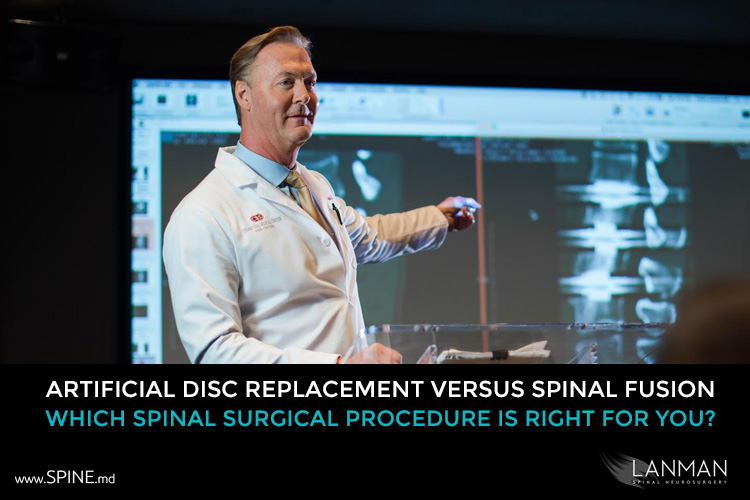


The big difference between artificial disc replacement surgery and spinal fusion surgery is dependent on the severity of the case I’m treating. Either procedure may apply for cervical, or lumbar regions of your back (neck, lower back, respectively).
Keep in mind that there are several treatments and non-surgical or minimally invasive procedures I may recommend for my patients before I consider either of these surgical procedures. In previous articles, I explain that, where your spine is concerned, time will determine which options are available. Generally speaking, if you are experiencing chronic and persistent pain in your spine, the sooner you visit your doctor, the more treatment options you will have.
If I narrow the treatment options to either disc replacement surgery or what we call fusion box or fusion surgery, when do I recommend one over the other? To help me determine which options are applicable, I will rely on the results of your scan and the range of symptoms that you are experiencing. My examination will focus on producing the best possible outcomes from the least invasive surgical procedure with the shortest possible recovery time.
Artificial disc replacement surgery is optimal if you have neck or low back pain associated with degenerative disc disease or degenerative herniated disc. A severely herniated or protruding disc may “pinch” a nearby nerve and trigger pain in the extremities (arms or legs), shoulder blades, or buttocks. However, successful artificial disk replacement is largely dependent upon the condition of the bones in the spine. For instance, a scan will help me determine if the “facet joints” (the interlocking facing surfaces of the vertebrae bones) are not arthritic or severely degenerated. If the bone is healthy and the source of pain is due to the disc, then replacing the disc is likely the best option available.
On occasion, I will see a patient who has small cracks or fractures in the vertebrae (the fist-sized bones) in the back; or they may have arthritis in the facet joints. In these cases, spinal fusion surgery is probably the best option because I have to immobilize the joints to stop the pain.
Sometimes a patient is a candidate for one or the other procedure. Sometimes they are a candidate for both fusion and artificial disc. I’m from the latter group: I have three artificial discs in my lower back and fusion and an artificial disc in my neck. I am an example of what I call a hybrid solution.
Research has shown that – in cases where disc replacement alone is not enough – we can expect better long-term outcomes when we use both procedures. In my case, the best option in my neck was to fuse two vertebrae and add an artificial disc above the fused joints. This approach helped me preserve motion and prevent further degeneration of the discs above the fusion. To be clear, the hybrid approach does not eliminate the risk of additional surgery down the road, but my research has found statistically significant data that this method is likely to reduce the chance of adjacent level surgeries.
The length of the surgery for spinal fusion versus artificial disc replacement varies from patient to patient and the location of the surgery, but they are similar. The big difference is in the recovery time. Recovery from cervical (neck) artificial disc replacement is about one month faster than cervical fusion (about three months). When the surgery is in the lumbar area of the spine, artificial disc replacement often requires an overnight stay in the hospital (possibly one or two nights), but fusion typically requires two or three nights in the hospital.
Postoperative treatment is also different. With artificial disc replacement, I’ll wait eight weeks before I recommend aggressive stretching and strengthening exercises. Spinal fusion typically requires three months before I’ll prescribe a CAT scan to be sure the bone is healing appropriately. If all looks well, I’ll recommend exercises, but gradually increase the activity over time.
This article contains a general description of my methods of treatment. I never do anything until I get to know the patient and understand their situation. Above all, my goal is the preservation of motion because, as you know, movement is life!
Spine.MD has compiled everything you need to know about artificial disc replacement. Whether you need to know more about what it is, the procedure, or if artificial disc replacement is right for you, our ADR resources can help you make the right decision. Learn directly from a real spine surgeon, Dr. Lanman, that performs artificial disc replacement and is an ADR Lead Investigator regularly comparing artificial disc replacement surgery vs. fusion: